
 Tyler Kuehl
The Hockey Writers
Tyler Kuehl
The Hockey Writers
232
Reads
0
Comments
NCAA Hockey National Championship History: The 1980s
Since the initial NCAA tournament in Colorado Springs in 1948, 72 programs have been crowned the best team in college hockey in the United States. Some have won more than others, but all are proud to be champions, even if it was only once.
When the 1980s came around, the landscape began to shift ever so slightly. The WCHA still had a stranglehold on the championship picture, much of the credit goes to Wisconsin, holding their place as one of the top conferences in the country. However, the younger CCHA brought forward some of its talented programs as the decade wore on.
1980: University of North Dakota
The 1970s were tough on the Fighting Sioux, as they could not get over the humps of Wisconsin and Minnesota. After their tough loss to the Gophers in 1979, North Dakota felt they were on the heels of returning to glory.
Related: Jonathan Toews – Beyond the Glory
The Sioux were steady throughout the regular season and turned on the afterburners in February, winning their final eight games to clinch the top spot in the WCHA with a 25-8-1 record. Doug Smail and All-American Mark Taylor led the attack for North Dakota, Taylor finished second in the NCAA in scoring with 92 points, and Smail was fourth with 87.
The Fighting Sioux cruised to the national tournament after winning their sixth conference championship and earned a bye into the semifinal. After making easy work of upstart Dartmouth, North Dakota met CCHA Champion Northern Michigan in the final, who were making their first appearance in the national tournament.

The game proved to be no contest, as North Dakota dominated the play, outshooting the Wildcats by a 45-22 margin. Smail earned a natural hat trick by the second period and added another in the third to become only the third player in championship game history to score four goals in a game. The Sioux won their third title by a final score of 5-2.
1981: University of Wisconsin
To say the Badgers’ 1979-80 season was a disappointment would be an understatement. On top of missing the WCHA Tournament, the team finished with a record under .500 for the first time ever under legendary head coach “Badger” Bob Johnson.
The 1980-81 season started with a bang, as the Badgers earned a 7-1 record thanks to the play of Scott Lecy, Ron Vincent and John Newberry, the three went on to lead the team in scoring. Yet, Wisconsin stumbled through the remainder of the regular season, with a 16-12 record the rest of the way, but still finished tied for second in the WCHA standings.
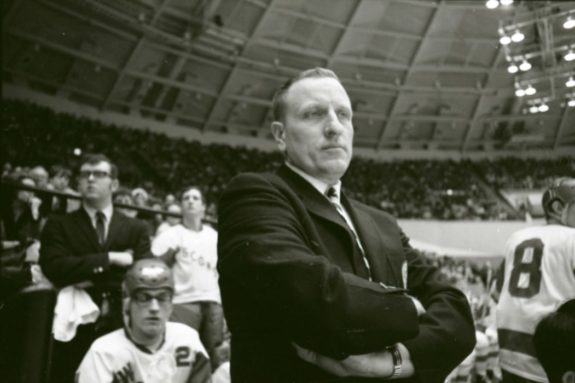
Even though they lost in the opening round of the WCHA Tournament, Wisconsin earned an at-large bid into the newly-renovated NCAA Tournament. With more teams than ever before, thanks to the increased number of programs in the CCHA, eight teams were allowed to compete. Wisconsin was given the fourth-seed in the West Region.
As the underdog against ECAC West Champion Clarkson, the Badgers upset the Golden Knights winning the series nine goals to eight (the tournament used aggregate scoring in the first round until 1990). After moving past Northern Michigan in the semis, Wisconsin met the WCHA Regular Season and Conference Champion Minnesota Golden Gophers in the final.
Despite losing three of four against the Gophers in the regular season, the Badgers held Minnesota and Hobey Baker Award-winner Aaron Broten at bay. Led by Newberry’s four-point game, the Badgers captured their first championship since 1977 with the 6-3 victory.
1982: University of North Dakota
After winning in 1980, the Fighting Sioux took a big step back in the 1980-81 season, falling to sixth in the WCHA standings, and getting bounced in the first round of the conference tournament. Gino Gasparini’s team was hungry to return to the top of the conference.
They certainly did in 1981-82. North Dakota finished with one of the best records in college hockey, 29-10 overall, and clinched the WCHA regular-season crown with a 19-7 record. Contrary to their 1980 offensive juggernaut, the Sioux had a much more balanced attack led by sophomore netminder Jon Casey, whose 2.77 goals-against average (GAA) was third in the NCAA, while his .908 save percentage (SV%) was tied for fourth in the country.
The Sioux made it into the tournament with an at-large bid after being embarrassed by Wisconsin in the WCHA Tournament finals, losing twice to the Badgers by a combined score of 12-1. The Fighting Sioux made easy work of Clarkson in the first round, winning the series 7-2. That was followed by a convincing win over ECAC Champion Northeastern.
Related: ‘Mr. Hockey’ Gordie Howe
North Dakota faced Wisconsin in the championship game. With the loss in the WCHA Final still in the back of their mind, the Sioux came ready to play. They outshot the Badgers 38-25 in the contest, and behind Phil Sykes’ hat trick, the Sioux won another championship, again 5-2.
1983: University of Wisconsin
The 1982-83 season was an intriguing one for the Wisconsin hockey program. Despite making it to the last two national championship games, and bringing back a boat-load of talent, it was the first season without Bob Johnson behind the bench after “Badger” took a job with the Flames, who had recently moved from Atlanta to Calgary.
However, with Johnson’s longtime assistant Jeff Sauer behind the bench, the Badgers were still at the top of their game. The team went 24-10-3 in the regular season, but their 15-9-2 conference record placed them third in the WCHA. Up front, Wisconsin was led by Paul Houck and All-American Patrick Flatley. Houck ended the season with 71 points, good for eighth in the country, while Flatley’s 69 points were tied for ninth.
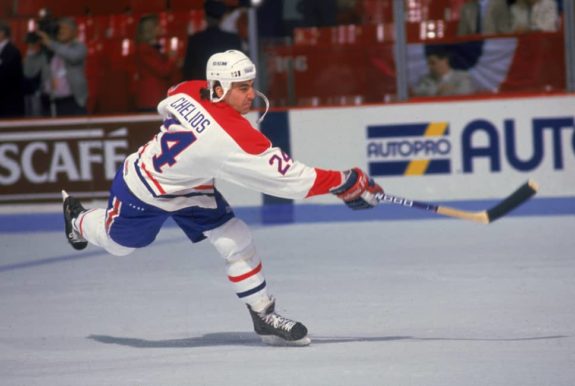
The Badgers won the WCHA Conference Championship after knocking off the regular season champs, Minnesota, in the final and went into the national tournament as the top-seed in the West. After making easy work of St. Lawrence in the first round, the Badgers slid by Providence to meet with ECAC Champion Harvard to decide the championship.
Even though the Crimson possessed the dominant Fusco brothers, Harvard could hardly find any offensive ground against the Badgers. Flatley’s two goals put Wisconsin in front, and they stayed there the rest of the way en route to their fourth championship with the 6-2 win.
1984: Bowling Green State University
In the conference’s first seven years of eligibility, only one team from the CCHA had made it to the championship game. That changed in 1984, when one of the league’s founding members, and predominant champions, made it to the top.
The 1983-84 season, led by head coach Jerry York, featured an outstanding start for the Bowling Green Falcons, going 20-1 into early January. The team cooled off the rest of the way, but finished the regular season with a 30-4-2 record, earning the CCHA’s regular-season title. Led by All-Americans Gary Galley and Dan Kane, the Falcons possessed a solid offensive attack, with strength in their own zone to boot. Goaltender Dan Kurzich was one of the best in the country, with a 2.87 GAA that was fourth in the NCAA.
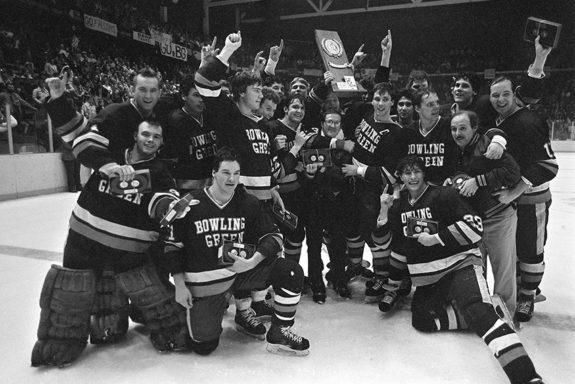
The Falcons lost to Western Michigan in the CCHA semifinal, but still qualified for the national tournament. After losing their first game in the opening round to Boston University 6-3, the Falcons bounced back to win game two 4-1, forcing overtime to decide the series. The Falcons got the tally in overtime to move onto the semifinal, where they knocked off CCHA-rival Michigan State.
This set up a meeting in Lake Placid between two first-timers in the championship game, as the Falcons went up against Minnesota-Duluth and Hobey Baker-winning defenceman Tom Kurvers. The teams traded goals in the first period before the Bulldogs scored twice to take a 3-1 lead; they had a 4-2 lead with only minutes remaining in the third period. Bowling Green bounced back with goals from Peter Wilson and John Samanski to send the championship game into overtime for the first time in seven years.
The first overtime solved nothing, neither did the second or third. Finally, with less than three minutes left in the fourth overtime, Kane found Gino Cavallini streaking towards the goal. Cavallini slid the puck into the back of the net, ending the longest game in championship history and giving the Falcons, and the CCHA, their first national championship.
1985: Rensselaer Polytechnic Institute
It had been 31 years since RPI had won its first national championship, but they were still a competitive team in a crowded ECAC. In 1984, they were knocked out of the first round by North Dakota, but the experience helped set up the Engineers for the 1984-85 season.
RPI started off inauspiciously, with a 4-2 record heading into American Thanksgiving. However, after losing to North Dakota on Nov. 23, the Engineers did not lose again. They won their final 25 games, finishing with a 28-2 record, one of the best in college hockey, to clinch the top spot in the ECAC. All-American Adam Oates was the offensive star for RPI, scoring 91 points, good for third in the country in scoring.
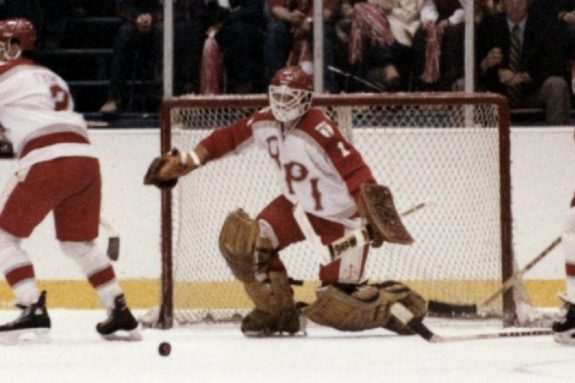
RPI won their second ECAC Tournament, before making their way past Lake Superior State in the first round. In the semifinal, they met 1984 runner-up Minnesota-Duluth, and Hobey Baker-winner Bill Watson. In a rather chippy affair, RPI needed a late goal from Ken Hammond to force overtime. The first two overtimes weren’t enough to determine a victor, but in the third extra frame, John Carter scored to send RPI to the championship game.
Exhausted from the night before, the Engineers had to quickly recuperate to take on ECAC-foe Providence, who also won their semifinal in triple-overtime but had a day’s rest before the final. Yet, while running on fumes, RPI dominated the play, doubling up the Friars in shots. With goals from Neil Hernberg and George Sivinis, and Darren Puppa battening down the hatches in goal, the Engineers won their second title with the 2-1 win.
1986: Michigan State University
Heading into the 1985-86 season, the Michigan State Spartans had made it to the national tournament in four consecutive seasons, only making it to the Frozen Four once. It looked like it was going to be a tough road for MSU in ’86, as the team started with a measly 11-7-1 record. However, after the team’s win in the annual Great Lakes Invitational, the Spartans took off, winning 16 of their final 18 games to claim the number-one seed in the CCHA.
Related: 7 Cool Things About Johnny Gaudreau
All-American Mike Donnelly led the charge for MSU, leading the team with 97 points to finish third in the country in scoring. Alternate captains Kevin Miller and Mitch Messier followed up admirably, scoring 71 and 64 points, respectively.
Even though they lost in the CCHA Tournament Championship Game to Western Michigan, the Spartans still earned a spot in the national tournament and made easy work of Boston College, the best team out of the ECAC. MSU then knocked off Minnesota in the semifinal, setting up a matchup with Harvard, who had defeated the best team in the NCAA that season, Denver, in their semifinal matchup.
The game was a wild, high-scoring affair. The Crimson jumped out in front by a pair, before each team traded two goals each. Trailing 4-2 in the waning minutes of the second period, the Spartans scored three goals less than four minutes apart to take the lead. Harvard came back to tie the game shortly after MSU’s flurry, but Donnelly’s second goal of the game with less than three minutes remaining in regulation put the Spartans ahead. MSU held on to win their second national championship by a final score of 6-5.
1987: University of North Dakota
Having missed out on the last two national tournaments, the Fighting Sioux wanted to get back to the success they had achieved earlier in the decade. With a bolstered lineup from top to bottom, North Dakota had an incredible 1986-87 season.
The team was consistent throughout, going 31-7 and taking the top spot in the WCHA standings. With the help of the supporting cast of Bob Joyce and Steve Johnson, Tony Hrkac became the best player in college hockey. He finished the season with 46 goals and 70 assists, the most in the NCAA, and became the program’s first Hobey Baker winner. The team was feeling confident heading into the postseason.
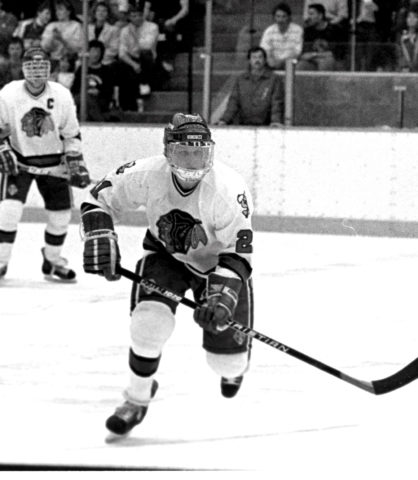
The Sioux whisked their way to another WCHA championship, and after easing their way by St. Lawrence and Harvard, North Dakota met the defending national champions, Michigan State, in the final in front of a Spartan-partisan crowd at Joe Louis Arena. The Sioux built a three-goal lead in the opening frame and were able to coast the rest of the way. Despite a late flurry by the Spartans, Ed Belfour held the fort in goal, and North Dakota won the game 5-3, taking home their third championship of the decade.
1988: Lake Superior State University
The CCHA was slowly gaining national prominence with the success of programs such as Michigan State and Bowling Green. Another team that was on the rise was Lake Superior State, who made the tournament only once before the 1987-88 season.
The Lakers played solid hockey during the regular season, picking up more ties than losses. LSSU ended up with a 27-5-6 record and were the best team in the CCHA. All-American Mark Vermette led the charge for the Lakers, with his 75 points that ranked sixth in the nation, and his 40 goals were more than anyone else in the NCAA. Bruce Hoffort was one of the best goaltenders that season. His .909 SV% ranked third in the county, while his 2.65 GAA was number one among goaltenders.
1988 marked the first time the tournament featured 12 programs, with four earning a bye into the quarterfinal. Even though they lost in the CCHA Championship, the Lakers earned a bye and knocked off Merrimack with a pair of convincing wins. Lake Superior State made it to the championship game after easily making their way past Maine to meet St. Lawrence in the final.
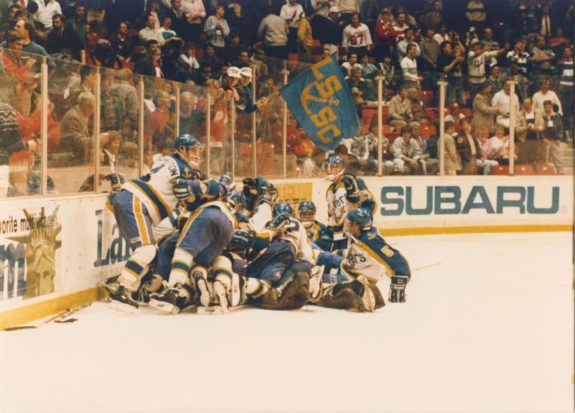
The Lakers took an early two-goal lead, but not before the Saints came back to tie the game in the second period. Each team traded goals before the period ended, with the game deadlocked heading into the third period. There was some controversy in the third, as late in the game, with the puck in the LSSU zone, Laker forward Pete Stauber knocked intentionally knocked the net off. Instead of the usual penalty shot, referee Frank Cole only called for a faceoff, leaving St. Lawrence players, coaches and fans irate at the non-call.
Nonetheless, the game headed into overtime. Less than five minutes into the extra frame, Vermette scored to give the Lakers their first national championship.
1989: Harvard University
Of all the teams that have won coming out of the ECAC, Harvard had fallen just short come tournament time, especially in the 80s. The Crimson had made it to the Frozen Four three times, losing in the final in 1983 and 1986. They looked to change their fortune heading into the 1988-89 season.
Related: Oilers History – The Paul Coffey Effect
The Crimson started the season on fire, going 15-0 through mid-January. They ended the campaign with an outstanding 24-2 record, taking the ECAC Regular Season Championship. While Peter Ciavaglia led the team in scoring with 63 points (10th in the country), Lane MacDonald was the unquestionable MVP. MacDonald’s play at both ends of the rink, on top of his 60 points, made him the third Crimson player to win the Hobey Baker Award.
The Crimson earned a bye into the quarterfinal, despite losing in the ECAC Tournament. They made easy work of the defending national champion Lake Superior State, before meeting Michigan State, the team that beat Harvard in 1986 in the semifinal. The Crimson took the Spartans down, earning the right to meet Minnesota in the final.
In front of a packed, Gopher-friendly, crowd at the old St. Paul Civic Center, the chances went back and forth. The Crimson’s Chuckie Hughes came up with a big goal to thwart the Gophers’ attack. Harvard led late into the third period, but Minnesota tied the game, and for the first time in championship game history, the title game would be decided in overtime in back-to-back seasons.
Just a few minutes into overtime, and after a Harvard faceoff win in the Gopher zone, Ed Krayer found a loose puck and slid it into the back of the net to win the game, and give Harvard the program’s first national championship.
During the 1980s the collegiate game was growing like never before. More teams in the tournament meant more opportunities for champions. Heading into the 1990s, Michigan’s Upper Peninsula featured some powerhouse teams, while the CCHA proved they were going to be a force to be reckoned with for years to come.
The post NCAA Hockey National Championship History: The 1980s appeared first on The Hockey Writers.
Popular Articles

















































 Blackhawks Chicago
Blackhawks Chicago Panthers Florida
Panthers Florida Penguins Pittsburgh
Penguins Pittsburgh Rangers New York
Rangers New York Avalanche Colorado
Avalanche Colorado Kings Los Angeles
Kings Los Angeles Maple Leafs Toronto
Maple Leafs Toronto Bruins Boston
Bruins Boston Capitals Washington
Capitals Washington Flames Calgary
Flames Calgary Oilers Edmonton
Oilers Edmonton Golden Knights Vegas
Golden Knights Vegas Islanders New York
Islanders New York Sabres Buffalo
Sabres Buffalo Red Wings Detroit
Red Wings Detroit Flyers Philadelphia
Flyers Philadelphia Senators Ottawa
Senators Ottawa Lightning Tampa Bay
Lightning Tampa Bay Devils New Jersey
Devils New Jersey Hurricanes Carolina
Hurricanes Carolina Blue Jackets Columbus
Blue Jackets Columbus Predators Nashville
Predators Nashville Wild Minnesota
Wild Minnesota Blues St. Louis
Blues St. Louis Stars Dallas
Stars Dallas Jets Winnipeg
Jets Winnipeg Mammoth Utah
Mammoth Utah Sharks San Jose
Sharks San Jose Canucks Vancouver
Canucks Vancouver Ducks Anaheim
Ducks Anaheim


